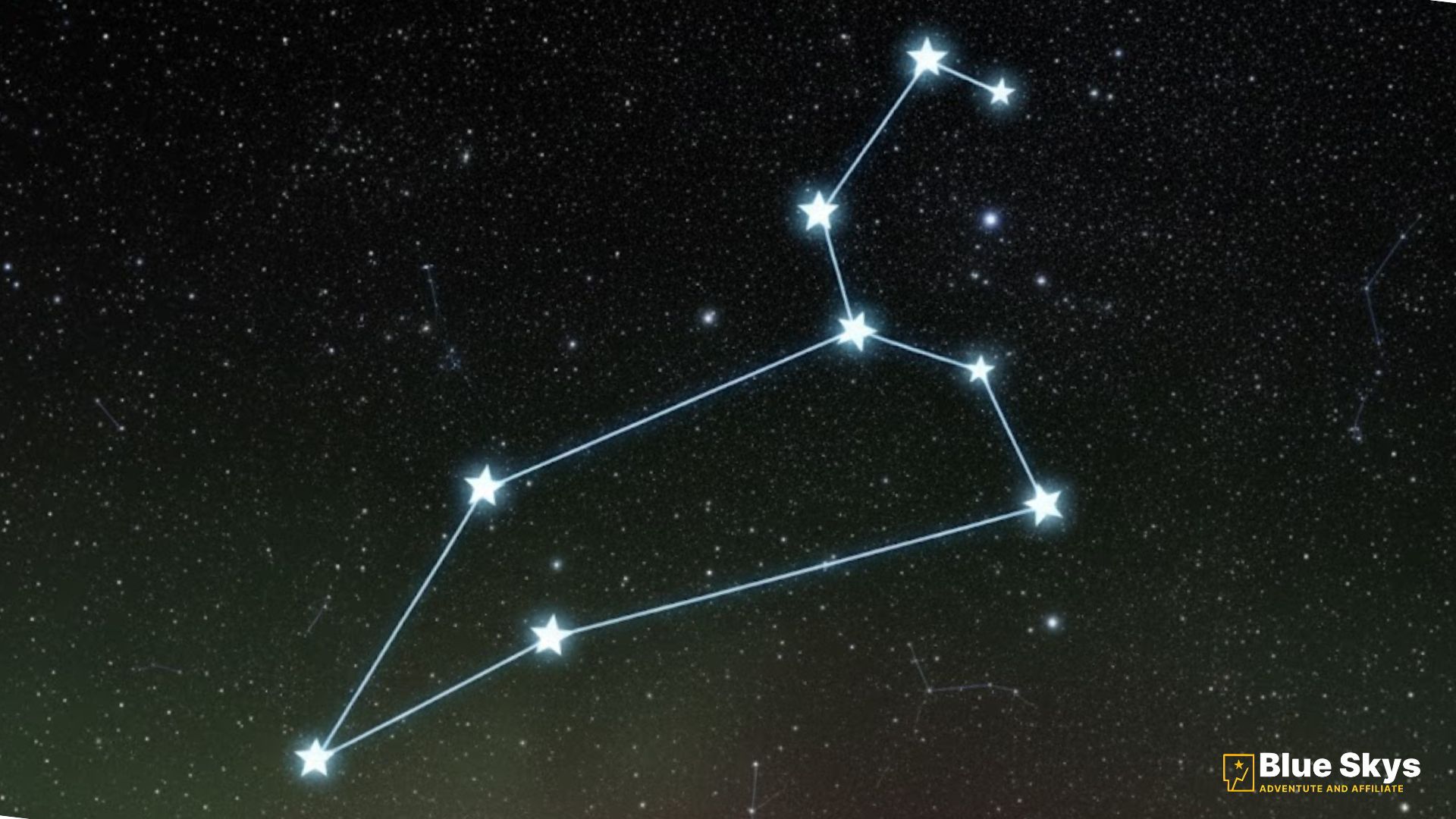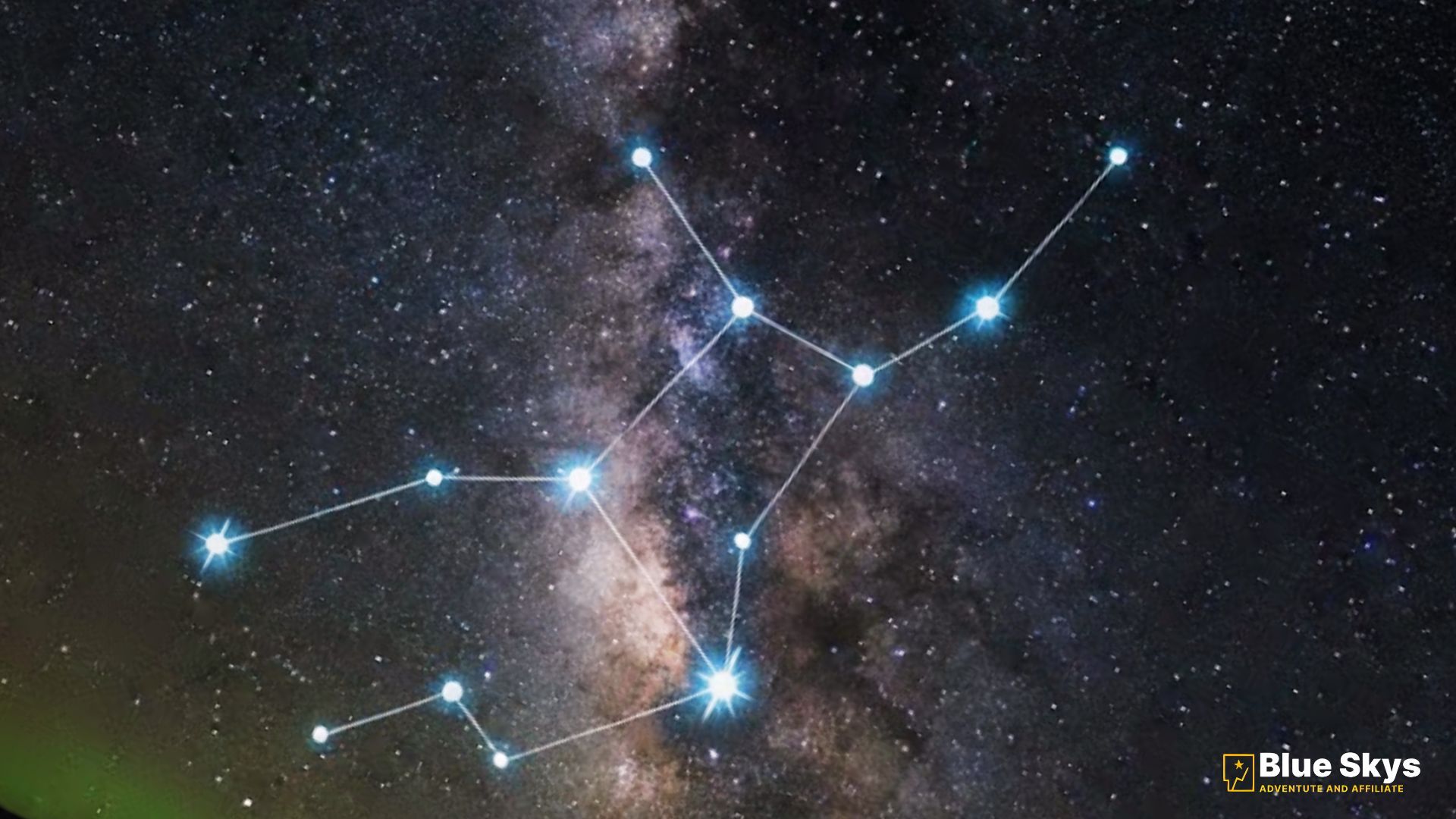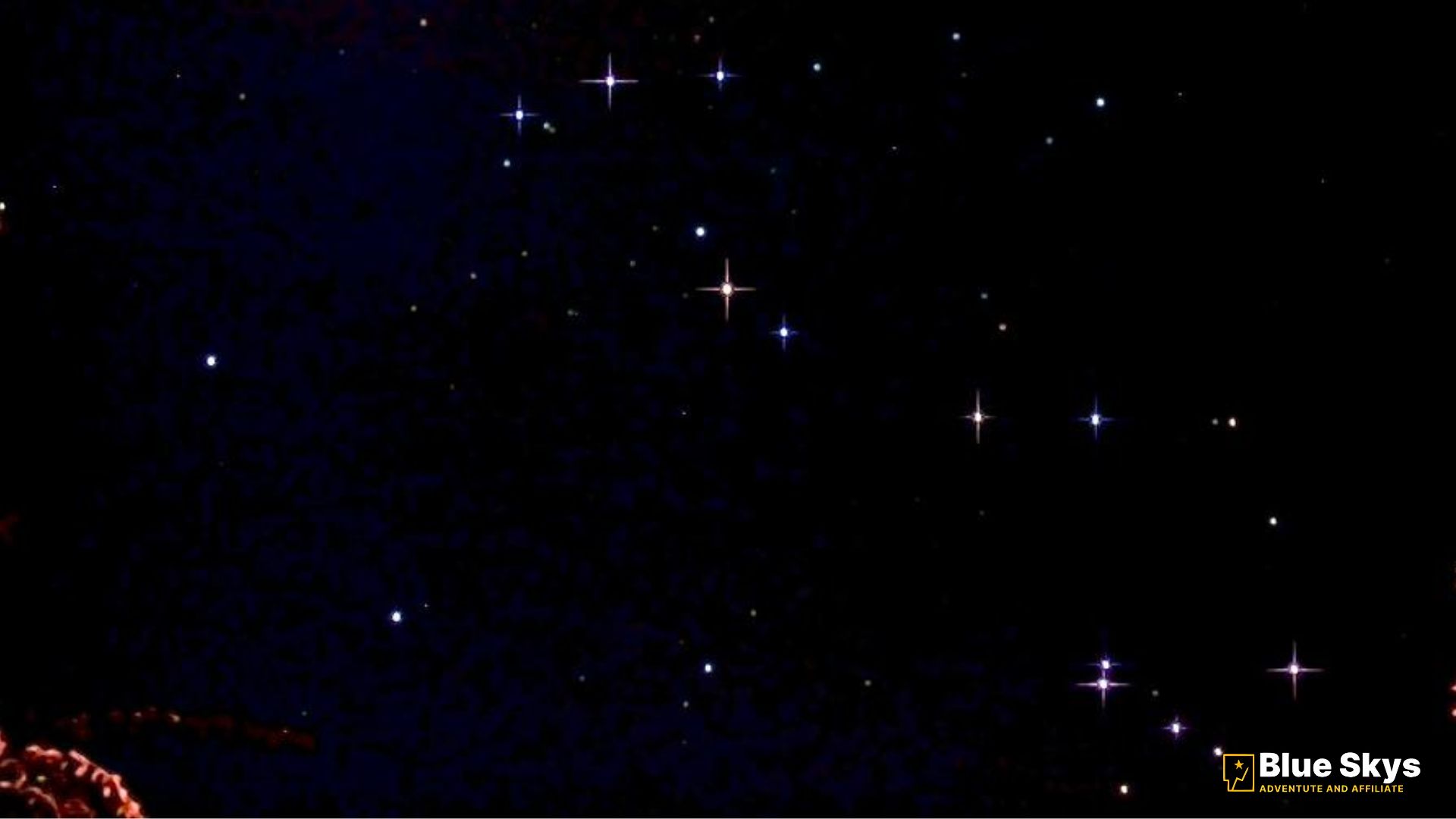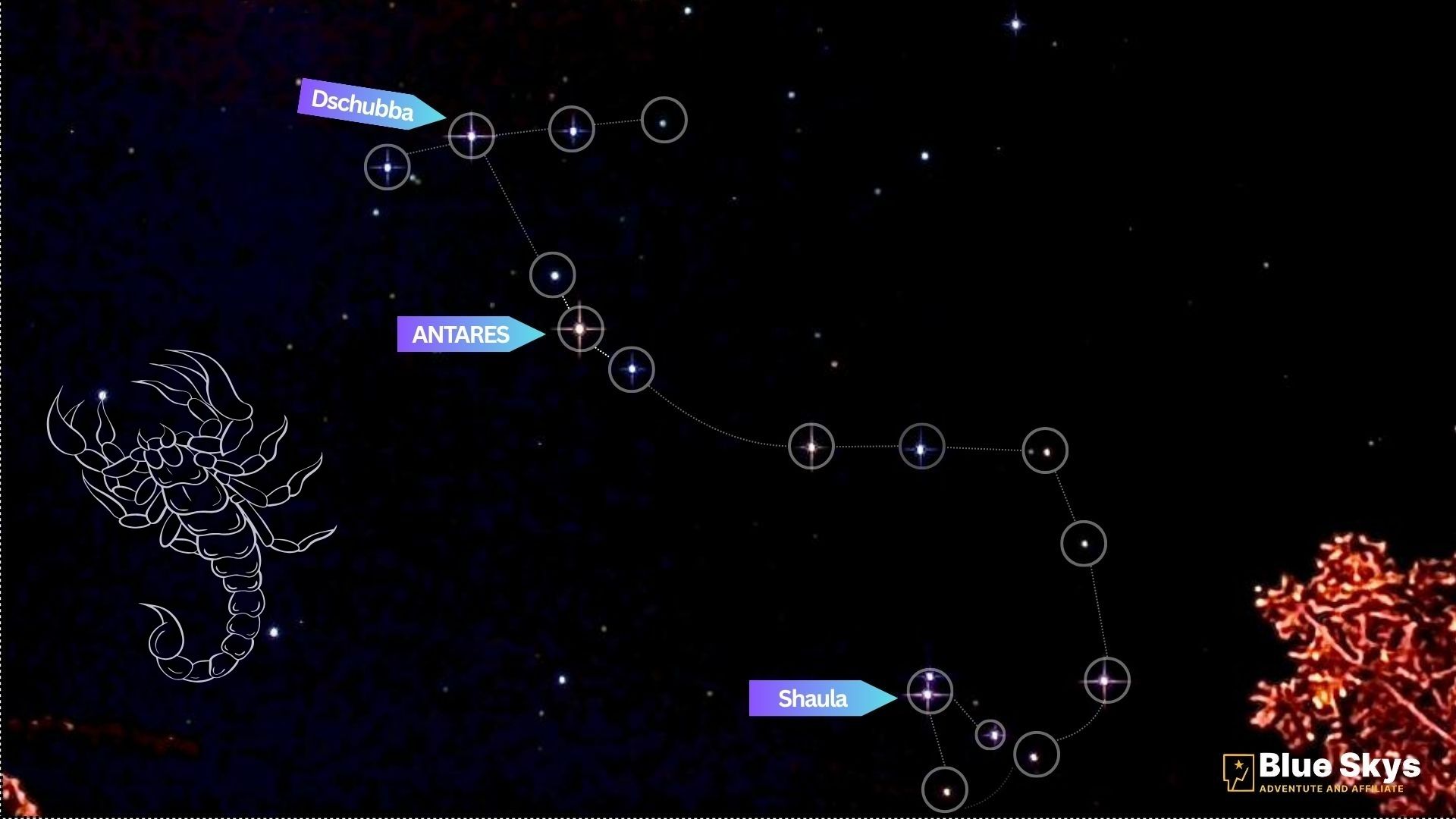Welcome to the night sky’s most spectacular show! Here’s what you need to know about finding the Orion the Hunter constellation for beginners. Why Orion is called ‘The Hunter’? This massive figure is one of the easiest landmarks to spot and the cornerstone of the Winter Constellations.
What is the Orion the Hunter Constellation?
The Orion the Hunter Constellation (Orion) is one of the brightest and most recognizable patterns in the night sky. It symbolizes a mighty hunter from Greek mythology, often depicted with a shield and club. This celestial figure spans the celestial equator, making it uniquely visible from nearly all parts of the Earth, lying between latitudes +85° and −75°. While known for its two brightest stars—the red supergiant Betelgeuse (α Orionis) and the blue supergiant Rigel (β Orionis)—the figure includes four other critical markers: Bellatrix (the left shoulder), Saiph (the right knee), and the three bright stars that form Orion’s Belt. Older astronomical texts frequently refer to the most famous deep-sky object in this constellation as the Great Nebula in Orion.
How to Find Orion the Hunter: A Simple 3-Step Guide
Orion dominates the night sky during the cooler months, making it one of the easiest constellations for a beginner to spot. Once you’ve learned major navigation points like the Ursa Major (Big Dipper) and Polaris, Orion is the natural next step. We’ll show you how to find Orion’s Belt easily.
- Know the Season: The constellation is best viewed in the evening sky during the Northern Hemisphere winter and the Southern Hemisphere summer, generally from November through March. In January, Orion’s Belt is typically highest around 9:00 PM.
- Locate the Belt: Scan the southern horizon (in the Northern Hemisphere) for three bright stars aligned in a distinct, short, nearly straight row. This highly recognizable pattern forms the Hunter’s Belt.
- Identify the Shoulders and Feet: Once the Belt is found, the rest of the figure becomes clear. The two bright stars north of the belt are the shoulders (including the distinctive reddish Betelgeuse), and the two bright stars to the south form the feet, featuring the brilliant, blue-white Rigel.
Star-Hopping from Orion’s Belt
Orion’s Belt acts as an essential celestial pointer for navigating the sky:
- To Sirius: Draw an imaginary line extending down and to the left through the three belt stars. This line points directly to Sirius, the brightest star in the entire night sky, located in the Canis Major constellation.
- To Aldebaran: Trace the same imaginary line up and to the right. This points toward the reddish star Aldebaran, the eye of Taurus, the Bull.
Wonders Within Orion: The Great Nebula and Brightest Stars
Orion is a spectacular constellation not only for its shape but for the bright, young stars and the enormous star-forming regions it contains. These regions contain incredible Nebulae such as M42 and the Horsehead.
Orion: A Massive Stellar Nursery
Orion is not merely a collection of stars; the entire constellation is embedded within the vast Orion Molecular Cloud Complex, a massive region of dust and gas that stretches across more than half of the figure. This complex is the closest region of massive star formation to Earth, containing stellar landmarks like the Horsehead Nebula, the Flame Nebula, the emission nebula Barnard’s Loop, **De Mairan’s Nebula (M43)**, and the reflection nebula Messier 78.
The Major Stars and Supernova Potential
The constellation is defined by the striking color and brightness contrast of its two main stars:
- Betelgeuse (The Right Shoulder α Orionis): This colossal red supergiant, located at Orion’s eastern shoulder, exhibits a distinctive orange-red hue, making it easily identifiable with the naked eye. It is incredibly massive (14–19 solar masses) and is in the final, unstable phase of its life. Astronomers hypothesize that when it finally collapses into a supernova. Which could happen at any moment. The resulting explosion would be as bright as the half-moon and visible even during the day for over three months. This spectacular event would be so luminous it could cast shadows at night. Betelgeuse’s dimming episodes, such as the major event in late 2019, are linked to traumatic outbursts where the star blew off material, signaling its chaotic stellar evolution.
- Rigel (The Left Foot β Orionis): As the brightest star in Orion and the seventh brightest in the night sky, Rigel is a luminous blue-white supergiant. Rigel’s name derives from an Arabic term meaning “the left leg of the giant”. Its intense blue-white glow is a result of an extremely hot surface temperature. Rigel is approximately 860 light-years away.
- Secondary Anatomy: The constellation’s remaining primary stars are the blue-white Bellatrix (the left shoulder) and Saiph (κ Orionis), which marks Orion’s right knee.
- Orion’s Belt Stars: The three central stars—Alnitak, Alnilam, and Mintaka—are all massive blue supergiant stars. Mintaka (δ Delta Orionis) is actually a complex quintuple star system located closest to the celestial equator, while Alnitak (ζ zeta Orionis) is a triple star system located at the eastern end of the belt.
Orion’s Sword: The Great Nebula (M42) and De Mairan’s Nebula (M43)
Hanging below the Belt is the asterism known as Orion’s Sword. Which contains the most spectacular deep-sky objects in the constellation. The middle “star” in the sword is a bright, fuzzy patch: the Great Orion Nebula (M42). If you’re wondering what is the best time to see the Orion Nebula? See the section below on peak visibility for optimal viewing clarity.
- M42: The Great Nebula: M42 is the closest region of massive star formation to Earth, located approximately 1,344 ± 20 light-years away. Older texts often call it the Great Nebula in Orion. Spanning 24 light-years and possessing a mass 2,000 times that of the Sun, this immense region is where stars and planetary systems are actively forming. Astronomers have directly observed fascinating features here, including an edge-on protoplanetary disk resembling an “interstellar Frisbee” around a newborn star—a process similar to how our own solar system formed 4.5 billion years ago. The central region features the Trapezium Cluster, a group of four tightly packed young, massive stars that illuminate the entire nebula.
- M43: De Mairan’s Nebula: Just north of the main M42 structure, separated by a dark lane of dust, is Messier 43 (M43). Also known by the Low-Competition name De Mairan’s Nebula (or NGC 1982), M43 is a distinct, miniature star-forming region. While fainter than M42 (apparent magnitude 9.0), M43 is visible through small binoculars and telescopes and serves as a vital component of the larger Molecular Cloud Complex.
When is the Best Time to See Orion from?
Orion is a winter constellation in the Northern Hemisphere and a summer constellation in the Southern Hemisphere. Or more percisely, its visibility shifts seasonally:
- Peak Viewing Time: The constellation is visible in the evening sky from November to May. But its peak visibility occurs between November and February.
- In Mid-Northern Latitudes (e.g., North America, Europe): Orion is best seen on winter nights, dominating the southern sky. Around 9:00 PM in January, the constellation reaches its highest point in the sky (the local meridian).
- In Southern Latitudes (e.g., Australia, South Africa): Orion is prominently visible during the summer evenings.
- Near the Equator: In countries close to the equator, Orion can appear nearly overhead around midnight in December.
Orion is generally in the daytime sky from May to July and thus invisible during that period at most latitudes.
How to Maximize Your View (Naked Eye and Binoculars)
To fully enjoy objects like the Orion Nebula and other deep-sky targets:
- Use Averted Vision: Since the M42 Nebula is faintly visible to the naked eye. Try looking slightly away (to the left or right) of the area you are targeting. This technique, known as averted vision. It utilizes the parts of your retina most sensitive to gray tones and darkness, helping you perceive dimmer objects.
- Low Power, Wide Field: Even simple binoculars offer a spectacular “lost in space” view of the Orion Nebula. And the surrounding star clusters. Low magnification and a wide field of view are often better than high magnification for viewing large, diffuse targets.
Ready to Hunt? Your Next Stargazing Adventure
The Legacy of Orion: Myths Across Cultures
The constellation’s visibility across the celestial equator meant it held great significance for cultures around the world.
- The Egyptians: The three stars of the Belt were seen as the resting place of the soul of the god Osiris.
- The Mayans: The Orion Nebula (M42) was believed to be the “cosmic fire of creation“.
- The Arabs: The star Rigel derives its name from an Arabic term meaning “the left leg of the giant“, and Hatsya (at the tip of Orion’s Sword) is sometimes known by the Arabic name Nair al Saif, meaning ‘bright one of the Sword‘.
- Global Variations: The Maori people of New Zealand saw the constellation as Te Waka o Tamarereti, a great celestial canoe, used for navigation and marking seasonal changes for fishing and planting. In India, it is Mriga (the Deer).
The Orion the Hunter Constellation serves as a perfect starting point for any stargazing journey. Its brightness and distinct shape make it an invaluable aid for star-hopping to fainter targets. Using its belt to point the way to other major stars like Sirius and Aldebaran.
Even without a telescope, you can greatly enhance your view by using a pair of simple binoculars. Which will reveal the cloud-like nature of the Orion Nebula and the countless stars surrounding it. For the best possible naked-eye viewing experience, find a Dark Sky Destination away from bright lights.





